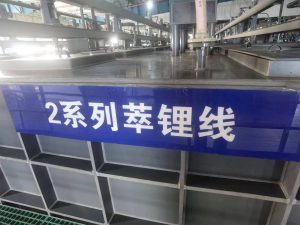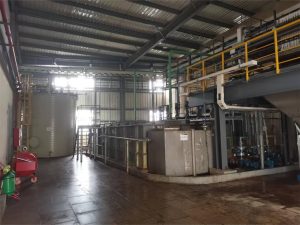Solvent extraction in lithium battery recycling involves using specific solvents to selectively recover valuable metals like lithium, cobalt, and nickel from spent batteries. This process can achieve metal recovery rates over 95%, significantly reducing the environmental impact and need for mining new materials.
The solvent extraction in real life
But next imagine that now you are standing in your local recycling factory and see all the used batteries recycled to use again. It all begins with what’s referred to as the “black mass” — a nasty, muddy concoction comprised of everything from pulverized battery cells. While it might not be very pretty to look at, inside its confines lie untapped precious metals.
Most setups you’ll find in these facilities will have a couple of big tanks of commercial solvents that get circulated through the black mass so as to strip out whatever metals they’re specifically designed for. The equipment employed here isn’t a household appliance; it’s high-tech extractors processing thousands of liters of material at once. This is on an order of magnitude that can deal with hundreds of car batteries at a time.
How is the solvent chosen? It’s not random. Matching the Right Solvent with the Right Metal Chemists and engineers are now working together to find a solvent that works best for recovery of individual metals. For example, one of the solvents commonly used for lithium processing is a group of organic chemicals chemically engineered to attach itself only with lithium ions and not other metals present in the solution.
Breaking it down, Solvent extraction can achieve a metal recovery percentage of over 95% for metals like Cobalt and Nickel. This translates into the recovery and reuse of 95 kilograms or more, i.e. at least in excess of a huge bulk out of every 100 kg waste management as battery wagons.

Why Solvent Extraction is so Important in Recycling
What is Solvent Extraction & Why you should care? After all, it is no mere process — the hero of battery recycling. A method that has yielded a near 100% extraction of precious metals from old batteries. This is not only green, it is also smart economics and smart chemistry.
How about if we take a closer look inside one of these battery recycling plants during a regular working day. In here, enormous vats of some mysterious liquid as well as large and complex machineries lay waiting for their dose to perform one duty: disassemble recyclable battery materials. State-of-the-art technology facilities, designed specifically to cater for the intricacies of solvent extraction. It is a bustling operation; workers are making sure the proper conditions required to ore cobalt, nickel, and lithium from other material.
Okay, But How Engaging Is It Really? Consider this: on the one hand, solvent extraction can recoup around 95 tons of metals from every 100-ton lithium-particle batteries that it forms. But these metals are more than that, they represent the foundation elements of new batteries. This is a closed loop process and is not sustainable, but also very cheap.
Another to consider is that each step in the solvent extraction process is tailored towards individual metals within a given sample, producing better recovery and more pure final products. For example, some kinds of solvents bind well with lithium and therefore remove more selectively lithium out of the mixture. This is important for preventing waste and extracting a higher quality material.
These are the main steps in solvent extraction for battery recycling
First up, Leaching. Now, take a step in time and imagine the crushed mix that is your battery’s core materials known as black mass soaking in a chemical bath. This is not an ordinary bath, it’s a controlled etchant for extracting useful metals from the waste. High precision is the name of the game—plotted to decimal places for Conditions like temperature and pH- so that no metal goes unturned.
Moving on to Separation. The solution is now precipitated, and the SO2 generated in this operation will be used to supply an acid treatment from where a purified residue containing Pt can be obtained. It is as if a huge sieve filters out all the non-soluble debris, leaving us with this gold-containing liquid full of ions. This step is very important — preparing the canvas before we actually start with extractions proper.
This brings us to the star of the show: Solvent Extraction. This is where it gets sneaky. The metal-laden solution is contacted with an organic solvent. Because it loves to scavenge lithium and cobalt directly out of the aqueous phase. It’s sort of like fishing — what bait will have the best chance at landing me a trophy fish? The result? The metals pass into the solvent, forming an aqueous layer rich in those metal ions.
Followed by the Stripping phase. Picture the big reveal. This treated metal-rich organic layer is then washed in another solution that removes the metals from the solvent. This bait and switch is important though, as this further cleans our target metals to prepare them for the last mile.
Finally, Metal Recovery. This is the fun part, where we make all of that hard work finally pay off. Methods including electrolysis, which converts the purified metal ions into solid metals. Then you flip a switch and the metal comes out of solution — it’s magic, but not really! Recovery rates are in the 95% range, which means almost all of these metals can be used again to make new batteries.

Benefits of Solvent Extraction
Efficiency and Selectivity
If you were shopping at a farmer’s market for the juiciest apples, Solvent extraction acts on a molecular level, and is effectively selective intermolecular bonding process which pulls the particular valuable metals into another solvent. This is not just random cherry-picking; we have a specific targeted approach where nearly all of the metals from ROM material, such as lithium, cobalt and nickel are recovered efficiently. Consider the success ratio — sometimes higher than 90%. According to the German firm, more than 90 kilograms of metals are recovered for every 100 kilograms of battery waste that is treated.
Reduced Environmental Impact
Now imagine a mine — large in scale, wrought with ecological disturbance and the heavy boot print of industry. This sounds like a situation that we want to avoid, and solvent extraction allows us to do just that. Be it either for resource savings (we no longer need to mine fresh materials) or, even better: By reclaiming metals from spent batteries. ^^ Think of it as a second harvest, but cultivated from the same field, greatly mitigating our environmental footprint. It also is not only good practice; it is positive strides in the right direction from overexploiting resources.
Cost-Effectiveness
The solvent extraction process can cost about $5,000 per ton of lithium recovered, which is significantly cheaper than the $10,000 per ton cost associated with mining new lithium. This 50% reduction in costs illustrates not only the economic efficiency of recycling but also its potential to offer substantial savings in the raw material supply chain for battery manufacturers.
Resources to support the Circular Economy
Every metal recycled is one less that has to be mined from our finite planet and reinjected into a linear economy! Not only the recycling approach but they also focus on keeping materials in circulation for as long possible, reducing waste and new resources.
